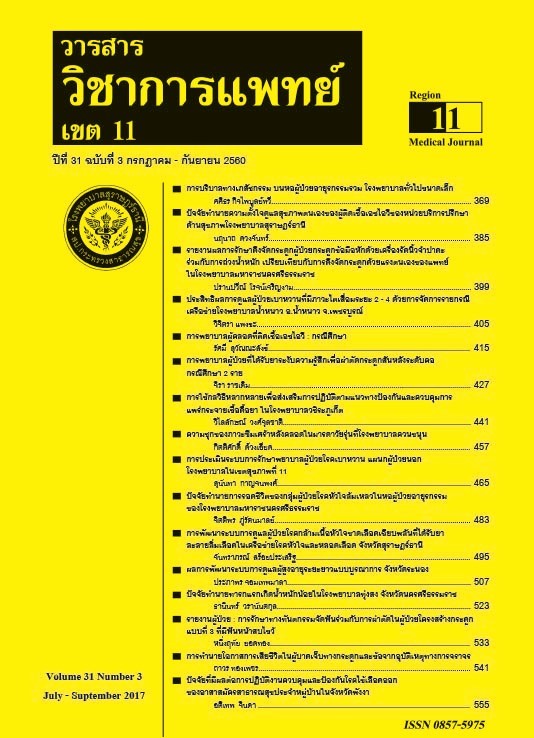Nursing care for HIV- Infected pregnant Women: case study
Keywords:
HIV infection, Nursing care, ante-natal care, intra-partum careAbstract
HIV infection could cause acquired immunodeficiency syndrome or AIDS. When human body has received a HIV virus, it has demolished white blood cells which were an immunization of human body. Therefore, the immunization has been decreased, which could make an opportunistic infection easily. HIV virus could contact by blood, sperm, vaginal discharge from unsafe sex, receiving blood with contaminated HIV virus, and mother to child HIV transmission during ante-natal care intra-partum care and post-partum care or by breast feeding. The affect of pregnant women with HIV infection could increase abortion rate, intrauterine growth retardation, still birth , prematurity, low birth weight infant, and dead fetus in utero.
The mother to child HIV transmission rate had 4.6 percent in 2008, whereas it had been decreased at 2.8 percent in 2012 and 1.9 percent in 2016. The ministry of public health decreed the goal of mother to child HIV transmission rate would be less than 1 percent in 2020. During 2014 to 2016, Samutprakarn hospital had had pregnant women with HIV infection 49 patients, 55 patients, and 62 patients perspectively, whereas the mother to child HIV transmission rate were 10.6, 4.68, 7.14 percents perspectively. The trends of this mother to child HIV transmission has increased, which derived from late antenatal care or no attend to antenatal care, inconsistent taking ARV medication, women with HIV infection got pregnant by concealed HIV result from husband. All those causes could bring highly mother to child HIV transmission. Therefore, standard health care system, particularly on nursing care for HIV–infected pregnant women was very important in term of continuing care during ante-natal care, intra-partum care, and post-partum care, which could be beneficial for mothers with HIV-infected to become healthy, bring back to normal living with their families, and ceasing from mother to child HIV transmission.
References
2. จารุวรรณ ก้าวหน้าไกลและคณะ. การพยาบาลสตรีตั้งครรภ์ที่ติดเชื้อเอชไอวี : สถานการณ์ท้าทายกับทางเลือกที่เปลี่ยนไป. วารสารสมาคมพยาบาลสาขาภาคตะวันออกเฉียงเหนือ,2012; 30 (2) : 6 – 15.
3. กรมควบคุมโรค กระทรวงสาธารณสุข. แนวทางการตรวจรักษาและป้องกันการติดเชื้อเอชไอวีประเทศไทย 2557. กรุงเทพ:โรงพิมพ์ชุมนุมสหกรณ์การเกษตรแห่งประเทศไทย จำกัด, 2557.
4. จุฬาลักษณ์ จิระพัฒน์สกุล. การติดเชื้อเอชไอวีในสตรีตั้งครรภ์. ค้นเมื่อเดือนมกราคม 12, 2560,จากhttp:/www.medicine.cmu.ac.th/dept/obgyn/2011/index.php?option=com_content&view =article&id=1293:2016-12-10-23-36-57&catid=45&Itemid=561.
5. แนวทางการดำเนินการเพื่อป้องกันการถ่ายทอดเชื้อเอชไอวีจากแม่สู่ลูกสำหรับประเทศไทย. ค้นเมื่อเดือนกุมภาพันธ์ 5, 2560, จาก http://203.157.45.67/napha9/aidspolicy.html.
6. นิตยา แก้วร่วมวงศ์ และอัญชัน สิงห์ชัย. (2552). การตั้งครรภ์ของผู้ติดเชื้อเอชไอวีที่รับยาต้านไวรัส.วารสารโรคเอดส์ 2552, 21 (3) : 143 – 157.
7. Taha TE, Dallabetta GA.et al. The effect of human immunodeficiency virus on birthweight, and infant and child mortality in urban Malawi. Int J Epidemiol 1995,24 (5) : 1022 - 9.
8. Cooper ER, Charurat M, Mofenson L, Hanson IC, Pitt J, Diaz C, et al. Combination antiret roviral strategies for the treatment of pregnant HIV -1- infected women and prevention of perinatal HIV-1 transmission. J Acquir Immune Defic Syndr 2002, 29 : 484 – 94.
9. Suksomboon N, Poolsup N, Ket-Aim S. Systemic review of the efficacy of antiretroviral therapies for reducing the risk of mother – to – child transmission of HIV infection. J Chin Pharm Ther 2007, 32 (3) : 293 - 311.
10. Lothian, J. A. The journey of becoming a mother. Journey of Perinatal Education 2008, 17 (4) : 43 – 47.
11. นิพรรณพร วรมงคล,นรีลักษณ์ กุลฤกษ์, ไฉไล เลิศวนางกูล. แนวทาง การปฏิบัติงาน และการดูแลแม่และลูกที่ติดเชื้อเอชไอวี. กรมอนามัย กระทรวงสาธารณสุข, 2549.
12. สุภาพ ไทยแท้. ผลของโปรแกรมการเสริมพลังอำนาจต่อความสามารถในการดูแลตนเองและการดูบุตรของมารดาหลังคลอดที่ติดเชื้อเอชไอวี. วารสารพยาบาลสาธารณสุข 2011, 25 (3) : 49 - 61 .






